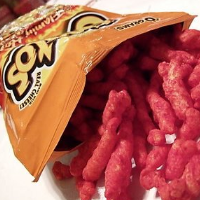Flamin’ Hot Cheetos Are Even Too Junky for Junk-Food Loving Schools

Schools in the Pasadena Unified School District have put out the word on Frito Lay’s Flamin’ Hot Cheetos. Even in a junk food world, where obesity rates of American children have tripled since 1980, and schools have limited control over what students put in their bodies, Flamin’ Hots are not welcome.
The district has already banned candy and junk food at elementary schools and limited its availability in upper grades, but pretty much left it up to individual principals to decide on more specific embargos. At Andrew Jackson Elementary School, Flamin’ Hot Cheetos just made the banned list and will be confiscated on sight. “We don't encourage other chips, but if we see Hot Cheetos, we confiscate them—sometimes after the child has already eaten most of them,” Principal Rita Exposito told the Chicago Tribune. .
Flamin’ Hots are not the number one best-selling junk food in the country. That honor belongs to another Frito-Lay product—Doritos, according to market research data cited by the Tribune. But anecdotal evidence gathered by the newspaper from corner convenience stores that cater to kids bursting through the doors before school, points a greasy red finger at Flamin’ Hots as the junk food of choice.
“It's my No. 1 seller,” Ali Bawazir, who owns Touchdown Food Mart in Chicago's Lakeview neighborhood, told the Tribune. “Kids get 'em for breakfast too. They're crazy about them.”
Flamin’ Hots have high levels of salt, fat and artificial colors with little nutrition or fiber, i.e. typical junk food found loaded in school vending machines and packed into kids’ lunches. A 2.5-ounce bag contains 24 grams of fat and 550 milligrams of sodium—a quarter of the daily dietary allowance. One ounce, or about 21 pieces, is about 160 calories.
Ten years ago, California was the first state to ban soft drinks in grade schools and later extended the ban to high schools. The state has enforced nutrition standards on foods sold in vending machines at schools since 2007. But no one is fooling themselves that kids are eating healthy during the school day.
Junk food has long been a fan favorite in schools. Ashley Gearhardt, an assistant professor of clinical psychology at the University of Michigan, summed up the attraction for the Tribune. “It's something that has been engineered so that it is fattier and saltier and more novel to the point where our body, brain and pleasure centers react to it more strongly than if we were eating, say, a handful of nuts. Going along with that, we are seeing those classic signs of addiction, the cravings and loss of control and preoccupation with it.”
Studies show California students eat less junk than kids in other states, but as Daniel R. Taber, an author of a junk food study and a postdoctoral research associate at the University of Illinois at Chicago, told the New York Times, “Students may not be buying as many candy bars at school, but that doesn’t mean that they’re necessarily eating salads instead.”
A quick review of the 1,010 YouTube submissions on the subject indicates, what they’re eating is—Flamin’ Hot Cheetos.
–Ken Broder
To Learn More:
Flamin' Hot Cheetos Banned From Schools In California, New Mexico And Illinois (by Kathleen Miles, Huffington Post)
Flamin' Hot Cheetos Inspire Fanatic Loyalty Among Kids (by Monica Eng, Chicago Tribune)
Bans on School Junk Food Pay Off in California (by Anahad O’Connor, New York Times)
- Top Stories
- Controversies
- Where is the Money Going?
- California and the Nation
- Appointments and Resignations
- Unusual News
- Latest News
- California Forbids U.S. Immigration Agents from Pretending to be Police
- California Lawmakers Urged to Strip “Self-Dealing” Tax Board of Its Duties
- Big Oil’s Grip on California
- Santa Cruz Police See Homeland Security Betrayal in Use of Gang Roundup as Cover for Immigration Raid
- Oil Companies Face Deadline to Stop Polluting California Groundwater





